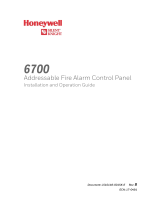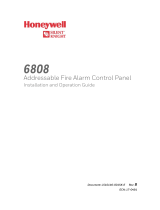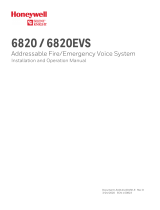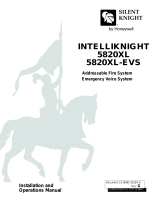Page is loading ...

B200SR-LF
Low Frequency Intelligent Sounder Base
INSTALLATION AND MAINTENANCE INSTRUCTIONS
3825 Ohio Avenue, St. Charles, Illinois 60174
1-800-SENSOR2, FAX: 630-377-6495
www.systemsensor.com
BEFORE INSTALLING
Read System Sensor’s Applications Guide for System Smoke Detectors
(SPAG91), which provides detailed information on sensor spacing, placement,
zoning, wiring, and special applications. This manual is available online at
www.systemsensor.com. NFPA 72 and NEMA guidelines should be observed.
The National Fire Alarm Code, NFPA 72, requires effective January 1, 2014,
that audible appliances installed in sleeping areas produce a low frequency
alarm signal that shall be a square wave or provide equivalent awakening abil-
ity with a fundamental frequency of 520 Hz +/– 10%.
NOTICE: This manual should be left with the owner/user of this equipment.
IMPORTANT: The detector used with this base must be tested and maintained
regularly following NFPA 72 requirements. The detector should be cleaned at
least once a year.
GENERAL DESCRIPTION
The B200SR-LF low frequency sounder base is used with System Sensor 200-Se-
ries sensor heads or equivalent. For a list of compatible sensors, refer to the Sys-
tem Sensor website at www.systemsensor.com. Refer to the appropriate manual
for more information on sensors.
The B200SR-LF low frequency sounder base generates a low frequency tone
around 520 Hz. Studies have shown that low frequency audible devices that
operate around 520 Hz are more effective in waking individuals in sleeping
areas. It offers maximum flexibility in configuration and operation to meet or
exceed the requirements of UL268 and UL464.
The sounder base is capable of producing either the distinctive three-pulse
temporal pattern (ANSI Temporal 3) fire alarm signal now required by NFPA
72 for commercial and residential applications or a continuous tone by simply
removing the included jumper from the device. Additionally, the B200SR-LF
is designed to be compatible with existing installations of B501-Series sounder
bases.
The sounder base is intended for use with intelligent systems. The sounder
base requires an external 24 VDC power supply. The connections for the
external power supply and the communication loop are isolated to prevent
electrical interaction between them. Refer to the panel manual for maximum
allowable number of units per loop.
NOTE: For NFPA72 Installations, the Temporal 3 tone should be used for public
mode evacuation.
NOTE: When not used as a supplementary evacuation system, the external 24
VDC supply shall be treated as a component of the main power supply system
and shall fall under the requirements of the main power supply system per
NFPA 72.
SPECIFICATIONS
Base Diameter: 6.875” (17.46 cm)
Base Height (less sensor): 2.0” (5.08 cm)
Weight: 0.6 lb. (272 gm)
Operating Temperature Range: Refer to applicable sensor Operating Temperature Range using the Base/Sensor Cross Reference Chart at systemsensor.com
Operating Humidity Range: 10% to 93% relative humidity (non-condensing)
External Supply Electrical Ratings
External Supply Voltage: 16 to 33 VDC (VFWR)
Standby Current: 1mA maximum VDC
Alarm Current: 65 mA maximum @ 33.0 VDC
90 mA maximum @ 24.0 VDC
125 mA maximum @16.0 VDC
SLC Electrical Ratings
SLC Operating Voltage: 15 to 32 VDC
SLC Standby Current: Refer to applicable sensor specification
Sound Output Greater than 85 dBA minimum measured in a UL reverberant room at 10 feet, 24 Volts (in continuous tone)
WIRING GUIDELINES
All wiring must be installed in compliance with the National Electrical Code
and the local codes having jurisdiction and must not be of such length or wire
size which would cause the base to operate outside of its published specifica-
tions. The conductors used to connect smoke sensors to control panels and
accessory devices should be color coded to reduce the likelihood of wiring
errors. Improper connections can prevent a system from responding properly
in the event of a fire.
Wire sizes up to 12 AWG (2.5 mm
2
) may be used with the base. The sounder
base will be shipped with the screw terminals set for 14 AWG wiring. If 12
AWG wire is to be used, back out the screws to allow the wire to fit beneath
the clamping plates. For best system performance, the power (+ and -) wires
and the communication circuit wires should be twisted pair or shielded cable
installed in a separate grounded conduit to protect the communication loop
from electrical interference.
Make wire connections by stripping about 3/8” of insulation from the end of
the wire. Then, slide the bare end of the wire under the appropriate clamping
plate (See Figure 1), and tighten the clamping plate screw. Do NOT loop the
wire under the clamping plate (See Figure 2) The wiring diagram for a typical
2-wire intelligent system is shown in Figure 4.
CAUTION
For system monitoring - for terminals 4 and 5, do not use looped wire under termi-
nals. Break wire run as shown in Figure 2 to provide monitoring of connections.
B200SR-LF TERMINALS
No. Function
1. Not Used
2. Positive (+) Comm. Line In and Out
3. Negative (-) Comm. Line In and Out
4. External Supply Positive (+)
5. External Supply Negative (-)
6. Sounder Base Interconnect
I56-4152-003R
1 I56-4152-003R
06-10

MOUNTING
Mount the B200SR-LF mounting plate directly to an electrical box. The plate
will mount directly to 4˝ square (with and without plaster ring), 4˝ octagon, 3
1
/2˝ octagon, single gang or double gang junction boxes.
1. Connect field wiring to terminals, as shown in Figure 1 and 2.
2. Attach the mounting plate to the junction box as shown in Figure 3.
3. To mount the sounder base, hook the tab on the sounder base to the groove
on the mounting plate.
4. Then, swing the sounder base into position to engage the pins on the
product with the terminals on the mounting plate.
5. Secure the sounder base by tightening the mounting screws.
6. Install a compatible smoke sensor as described in the installation manual
for the sensor.
TAMPER RESISTANT FEATURE
NOTE: Do not use the tamper-resist feature if the removal tool is to be used.
This detector base includes a tamper-resist feature that prevents its removal
from the base without the use of a tool. To activate this feature, break the tab
from the detector base as shown in Figure 6A. Then, install the detector. To
remove the detector from the base once the tamper-resist feature has been
activated, insert a small-bladed screwdriver into the slot from the top and
press down on the lever (see Figure 6B). This allows the detector to be rotated
counterclockwise for removal. The tamper-resist feature can be defeated by
breaking and removing the plastic lever from the base. However, this prevents
the feature from being used again.
TESTING AND MAINTENANCE
Sensors and bases must be tested after installation and as an integral part of a
periodic maintenance program. Test the B200SR-LF as follows:
NOTE: Before testing, notify the proper authorities that the smoke sensor
system is undergoing maintenance and, therefore, will be temporarily out of
service. Disable the system undergoing maintenance to prevent unwanted
alarms.
1. If configured as in Figure 4 and 5, reverse the polarity of the external 24VDC
supply. If configured as in Figure 5, turn on the Intelligent Relay Module.
All B200SR-LF bases on the loop should sound.
2. Latch the sensor LED on from the control panel. That individual sensor’s
B200SR-LF should sound.
When performing maintenance on connected smoke sensors, carefully note
the location and address of each removed sensor.
FIGURE 3: MOUNTING
FIGURE 2:
Location of jumper–
remove to enable
continuous tone
1
2
3
4
5
6
C0471-08
C0473-00
C0891-10
FIGURE 1:
2 I56-4152-003R
06-10

(+) SLC
(+) SLC
NO 1
NO 2
NC 2
COMM 2
COMM 1
NC 1
(–) SLC
(–) SLC
(–) POWER
(+) POWER
U.L. LISTED COMPATIBLE
CONTROL PANEL
OPTIONAL SOUNDER INTERCONNECT*
NOT
USED
SLC +
EXT –
EXT +
RA
SLC –
NOT
USED
SLC +
EXT –
EXT +
RA
SLC –
(+) SLC
(–) SLC
SUP (–)
SUP (+)
* GROUPING OF UP TO 6 MODEL B200SR-LF LOW FREQUENCY SOUNDER BASES
INTELLIGENT
MONITOR MODULE
INTELLIGENT
RELAY MODULE†
FIRST
SOUNDER
BASE
LAST
SOUNDER
BASE
†THIS IS A STANDARD RELAY
MODULE CONFIGURED TO
REVERSE THE POWER
UL LISTED
EOL
RESISTOR
47k
UL LISTED 24V
POWER SUPPLY
END OF LINE RELAY
(EOLR-1 OR EQUIV
ALENT)
TO OPTIONAL REMOTE
ANNUNCIATOR
MODEL RA400Z/100Z
FIGURE 4: WIRING DIAGRAM
FIGURE 5: WIRING DIAGRAM
(+) SLC
(–) SLC
(–) POWER
(+) POWER
U.L. LISTED COMPATIBLE
CONTROL PANEL
OPTIONAL SOUNDER INTERCONNECT*
TO OPTIONAL REMOTE
ANNUNCIATOR
MODEL RA400Z/100Z
CLASS A OPTIONAL WIRING
CLASS A OPTIONAL WIRING
NOT
USED
SLC +
EXT –
EXT +
RA
SLC –
NOT
USED
SLC +
EXT –
EXT +
RA
SLC –
(+) SLC
(–) SLC
SUP (–)
SUP (+)
* GROUPING OF UP TO 6 MODEL B200SR-LF LOW FREQUENCY SOUNDER BASES
INTELLIGENT
MONITOR MODULE
FIRST
SOUNDER
BASE
SECOND
SOUNDER
BASE
LAST
SOUNDER
BASE
UL LISTED
EOL
RESISTOR
47k
NOT
USED
SLC +
EXT –
EXT +
RA
SLC –
UL LISTED 24V
POWER SUPPLY
END OF LINE RELAY
(EOLR-1 OR EQUIVALENT)
C0970-14
C0970-15
DETECTOR ACTIVATES SOUNDER BASE(S) - (COMPLIES WITH UL268)
UL has approved grouping for up to six B200SR-LF low frequency sounder bases. When wired as a group, any detector in the group that has been activated by
the panel will cause other B200SR-LF units in the group to sound. This type of “local” grouping is accomplished by wiring the grouped devices together using
terminal 6, Sounder Base Interconnect, as shown in the diagram. This interconnect can also be used to attach B200SR-LF devices to System Sensor B501-Series
sounder bases. Some Fire Alarm Control Panels (FACP) support the grouping of sounder bases via software in lieu of the Sounder Base Interconnect.
NOTE: A local grouping of horns via the sounder base interconnect is not supervised, therefore the groups can only be used as a supplementary evacuation
system. It is not acceptable to group horns via the sounder base interconnect for primary alarm signaling. Sounder bases which are grouped via software are not
subject to this limitation and may be used as part of the primary alarm signaling.
DETECTOR ACTIVATES SOUNDER BASE(S);
INTELLIGENT RELAY MODULE ACTIVATES ALL SOUNDER BASES - (COMPLIES WITH UL 268 AND UL 464)
UL has approved grouping for up to six B200SR-LF low frequency sounder bases. When wired as a group, any detector in the group that has been activated by
the panel will cause other B200SR-LF units in the group to sound. This type of “local” grouping is accomplished by wiring the grouped devices together using
terminal 6, Sounder Base Interconnect, as shown in the diagram. Some Fire Alarm Control Panels support the grouping of sounder bases via software in lieu of
the Sounder Base Interconnect.
NOTE: A local grouping of horns via the sounder base interconnect is not supervised, therefore the groups can only be used as a supplementary evacuation
system. It is not acceptable to group horns via the sounder base interconnect for primary alarm signaling. Sounder bases which are grouped via software
are not subject to this limitation and may be used as part of the primary alarm signaling.
3 I56-4152-003R
06-10

System Sensor warrants its enclosed smoke detector base to be free from defects in ma-
terials and workmanship under normal use and service for a period of three years from
date of manufacture. System Sensor makes no other express warranty for this smoke
detector base. No agent, representative, dealer, or employee of the Company has the au
-
thority to increase or alter the obligations or limitations of this Warranty. The Company’s
obligation of this Warranty shall be limited to the repair or replacement of any part of
the smoke detector base which is found to be defective in materials or workmanship
under normal use and service during the three year period commencing with the date of
manufacture. After phoning System Sensor’s toll free number 800-SENSOR2 (736-7672)
for a Return Authorization number, send defective units postage prepaid to: Honeywell,
THREE-YEAR LIMITED WARRANTY
12220 Rojas Drive, Suite 700, El Paso TX 79936, USA. Please include a note describing the
malfunction and suspected cause of failure. The Company shall not be obligated to repair
or replace units which are found to be defective because of damage, unreasonable use,
modifications, or alterations occurring after the date of manufacture. In no case shall the
Company be liable for any consequential or incidental damages for breach of this or any
other Warranty, expressed or implied whatsoever, even if the loss or damage is caused by
the Company’s negligence or fault. Some states do not allow the exclusion or limitation of
incidental or consequential damages, so the above limitation or exclusion may not apply
to you. This Warranty gives you specific legal rights, and you may also have other rights
which vary from state to state.
Please refer to insert for the Limitations of Fire Alarm Systems
PLASTIC LEVER
BREAK TAB AT
DOTTED LINE BY
TWISTING TOWARD
CENTER OF BASE.
USE SMALL-BLADED
SCREWDRIVER TO
PUSH PLASTIC LEVER
IN DIRECTION OF
ARROW.
SLOT
C0144-00
C1082-01
FIGURE 6A:
FIGURE 6B:
4 I56-4152-003R
©2016 System Sensor. 06-10
/






